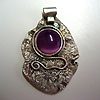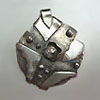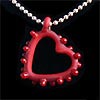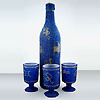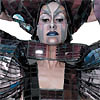February, 2008

From MyLovelyBeads.com TeamWe have already left Valentine's Day behind us, and we are looking forward to Spring! In this issue of MyLovelyBeads.com newsletter:
Amethyst - purple quartz
Contact us with any questions at
info@mylovelybeads.com.
Jewelry types by Eni Oken Featured artist - Hanna Ben-Nathan Do you know? Lampworking Cheers! Bead woven glassware Step by step - Lion Belt Buckle March upcoming events Best regards,
MyLovelyBeads.com Team |
Amethyst - purple quartzAmethyst is a form of the mineral quartz, and is a relatively common gemstone. Amethyst is usually purple, but can range in color from pale lavender to a very deep, reddish purple to a milky color to green. Deeper-colored amethysts are more highly valued. The name "amethyst" comes from the Greek A ("not") and METHUSTOS ("to intoxicate"), a reference to the belief that the stone protected its owner from drunkenness. Much fine amethyst comes from Russia, especially from near Mursinka in the Sverdlovsk region, where it occurs in drusy cavities in granite rocks. Many of the hollow agates of Brazil and Uruguay contain a crop of amethyst crystals in the interior. Many localities in India, the United States (Yellowstone National Park, Pennsylvania, Texas, North Carolina, Maine), Canada, South Korea, yield amethyst. The largest opencast amethyst vein in the world is in Maissau, Lower Austria. Amethyst was used as a gemstone by the ancient Egyptians and was largely employed in antiquity for intaglios. Beads of amethyst are found in Anglo-Saxon graves in England. Amethyst is a symbol of heavenly understanding, and of the pioneer in thought and action on the philosophical, religious, spiritual, and material planes. Ranking members of the Roman Catholic Church traditionally wear rings set with a large amethyst as part of their office. The ancient Greeks and Romans wore amethyst and made drinking vessels of it in the belief that it would prevent intoxication. Supposedly, when a drunken Dionysus was pursuing a maiden called Amethystos, who refused his affections, she prayed to the gods to remain chaste. The goddess Artemis granted the prayer, transforming her into a white stone; humbled by Amethystos' desire to remain chaste, Dionysus poured wine over the stone she had become as an offering, dyeing the crystals purple. Variants of the story include that Dionysus, the god of intoxication, had been insulted by a mortal and swore revenge on the next mortal who crossed his path, creating fierce tigers to carry out his wish; the mortal turned out to be a beautiful young woman, Amethystos, who was on her way to pay tribute to Artemis. Her life is spared by Artemis, who transforms the maiden into a statue of pure crystalline quartz to protect her from the brutal claws. Dionysus wept tears of wine in remorse for his action at the sight of the beautiful statue. The god's tears stained the quartz purple. Amethyst facts 1. A huge geode, or "amethyst-grotto", from near Santa Cruz in southern Brazil was exhibited at the Duesseldorf, Germany Exhibition of 1902. 2. The ideal amethyst grade is called "Deep Siberian" (or "Deep Russian") and has a primary purple hue of around 75-80 percent, 15-20 percent blue and (depending on the light source) red secondary hues. |
|
Jewelry typesThe jewelry industry recognizes several types of jewelry, when it comes to fashion and use of materials: Fashion Jewelry: usually created strictly according to the latest trends of each season, this kind of jewelry is not intended to last. Made of base metals and lower quality materials, it is created with more design in mind than preciousness. Typical price range is below $100. Fine Jewelry: the complete opposite of Fashion Jewelry, this type of jewelry is made to last, made with the most precious materials available. Nothing short of diamonds and high quality precious stones in classic settings with noble metals - high karat gold, platinum - made to last for generations. Engagement rings are a typical example. These pieces are also bought for the value of the materials and are intended to pass along as heirloom. Prices start at the high hundreds and usually can cost thousands of dollars. Bridge Jewelry: a new type of jewelry which is a mix between fine and fashion: these pieces are typically made with nice quality stones and better crystals, silver, gold-filled and sometimes low karat gold (14k). The design follows the trends somewhat, but the jewelry can still be passed along as heirloom. The intrinsic value is not as high as fine jewelry, though. Brand Jewelry: this type of jewelry relies on its value due to the name of the brand or designer. Tiffany is a good example. The materials can vary from medium to high quality and usually the pieces become collectible over time. Keeping the original box and the jewelry in good or mint condition is usually advisable in this case. |
|
Featured artist
Influenced by 3 different cultures, Hanna Ben-Nathan who was born in Europe, brought up in Israel and currently lives in South Africa, demonstrates in her work an interesting weave of cosmopolitan art. Silversmithing is a late occurrence in her life, although art in its different trends was always an integral part of her being. Raising four children, she was foremost a Mom and a wife, but her spare time was always dedicated to a wide variety of crafts. When the computer was introduced to her, graphic art enabled her to bring to life her vivid imagination. 8 years ago Hanna gave in to the strong urge to become a writer, which was a life long desire. She wrote her first novel and an endless string of stories and poems. Though content in her writing, she kept doing graphic arts and was planning to adorn her published book by her own work. A tragedy in the family brought to a complete halt her writing. To fill the void in her life, Hanna, in the last year, with the kind help of a friend, discovered silversmithing. It was a life-line which helped save her sanity and brought forth her natural talents. Shapes and textures are the main themes in her work. Old world pieces (Europe) mixed with Middle East boldness (Israel) down to the lively trends of Africa, all these make her work unique and interesting. Ideas come from all human senses, incorporating philosophical concepts and nature around us. Hanna is still taking classes and would like to expand her metal work to areas such as etching and chasing which she finds most challenging. She does not have a site of her own, yet, but you can see some of her work here on this newsletter or try the selling site in South Africa (like Ebay) at http://www.bidorbuy.co.za Read the full article on silversmithing by Hanna Ben-Nathan. |
|
Do you know? LampworkingWho knew that glass was so fickle? It is soft and pliable, fragile and capricious at the same time. It can take any shape in a master's hands. It can turn into an animal or an exquisite vase. It can flow, turn or stretch as the thinnest thread as on an order of a wand. Lampworking is glassworking using a torch to melt and manipulate the glass. The art form has been practiced since ancient times. Lampworking became widely practiced in the 14th century in Murano, Italy. The Italian artists kept the techniques secret. In the mid 19th century the lampwork technique was extended to the production of paperweights primarily in France. Then, around years ago, some American artists began experimenting with the glass they had available. The history of lampworking continues! Clare Scott, a glass artist from North Yorkshire, England, says, "I have been interested in jewelry making since a young age and I have been designing jewelry since I was at school. I loved looking through magazines bursting full of "findings" and spent all my pocket money on, but didn't realize you could actually make glass beads. After 11 years as a Veterinary Nurse, I stumbled across the art of Lampworking. Wow! I've been completely hooked (obsessed!!!) ever since. I find the amazing array of glass fascinating - more colors than you could ever imagine. I put my heart and soul into making each and every lampwork bead. They are a reflection of how I am feeling at that moment, the glass captures emotion and expressions. I love working with glass, its reactions and flow amaze me!" To see lampwork beads and jewelry made by Clare Scott, visit our gallery, or Clare's website at www.clarescott.co.uk. Read the full article on lampworking by Clare Scott. If you do not see the lampwork beads making video please click here. |
|
Cheers! Bead woven glassware
Natasha Berezovskaya is a Muscovite and is 43 years old. Her professional career lies with a publishing house in Moscow but her true interest rests with her artistic work. Beadwork attracted Natasha since she was a young school girl and her beading hasn't stopped since. In 1995, she took part in a craft fair and was amazed by the variety and complexity of professional beadwork. There and then Natasha decided to take beading classes in order to achieve the proficiency needed to produce pieces such as those she saw in the fair. Natasha sees beadwork not only as a craft but as a gate to a fantasy world, filled with fairies and flowers, a world with no boundaries and full of hope. With the years, her beading work took a turn and Natasha began to weave beads around glassware, creating beautiful designs to complement the original shape of decanters, bottles and carafes. Each piece has its own unique character and by using beads of all colors, Natasha creates a new medium in the world of beadwork.
Natasha's work can be seen at her gallery: bead woven glassware gallery. Contact Natasha with any questions at n-berezovskaya@mail.ru. Visit Natasha's website: www.biserinka.com. |
|
Step by stepThe author of the Lion Belt Buckle project is Hanna Ben-Nathan. She says, "This buckle takes a while to make and involves a lot of soldering and pickling. You don't have to finish it on one go - take your time and enjoy the work. I have not supplied the pattern for the lion's head. I'm sure each of you can find a design he likes, but if you do want this design - just let me know at hanna@ben-nathan.com. I assume that you are not a beginner, for I didn't go into details such as how to solder or saw." |
|
Upcoming events
February 22 - April 13, 2008 2008 Wearable Expressions International Juried Exhibition of Wearable Art will take place in Los Angeles area, among artists from all over the world are beaded jewelry artists: Zoya Gutina, Tatiana Van Iten, Lana May. To see the list of fiber and jewelry artists click here. |
© 2010 MyLovelyBeads.com All Rights Reserved.
If you do not want receive our newsletter and you wish to remove your email address from our mailing list, please click the following link to unsubscribe.




